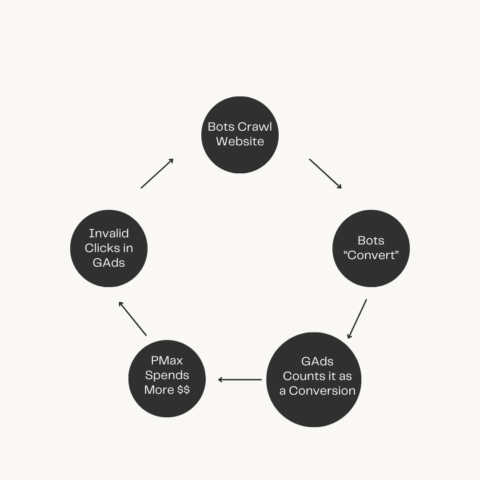Since its launch in 2021, Google’s Performance Max (PMax) campaigns have revolutionized how we approach cross-channel advertising.
But while this AI-powered campaign has been a game-changer for many, particularly in ecommerce, its application for lead generation comes with unique challenges and opportunities.
I thought this would be a good time to share advanced strategies for leveraging PMax in lead generation campaigns. We’ll also identify common pitfalls and reveal how to maximize your results.
The Lead Gen Challenge: Quality Over Quantity
Unlike ecommerce, where a purchase marks a clear end to the customer journey, lead generation is just the beginning.
This fundamental difference creates a significant hurdle for PMax campaigns, presenting unique challenges that require advanced strategies.
Menachem Ani, founder of JXT Group, explains the core issue:
“Unlike e-commerce, where a purchase signifies the ‘end’ of the transaction, lead creation is the beginning of the sales process—and just because someone fills out a form doesn’t make them a quality lead.”
The challenge lies in teaching Google’s algorithm to distinguish between high-quality and low-quality leads.
Without this crucial information, PMax campaigns can fall into what some marketers call the “feedback loop of doom” – optimizing for quantity over quality and potentially flooding your pipeline with unqualified leads.
 Image from author, September 2024
Image from author, September 2024Another critical factor in determining whether PMax suits your lead generation efforts is Google’s understanding of your business and website.
PMax heavily relies on your website content when targeting users. If Google misinterprets your service offerings, your campaigns are likely to underperform.
To assess Google’s comprehension of your business, try this simple test: Input your website URL into the Search Terms section of Google’s Keyword Planner.
Review the generated keywords and evaluate their relevance to your services. This exercise can provide valuable insights into how well Google understands your business, which is crucial for PMax’s success in lead generation campaigns.
Cracking The Code: Strategies For Success
1. Harness The Power Of Offline Conversion Tracking (OCT)
The key to success with PMax for lead generation lies in feeding Google’s algorithm with quality data. This means implementing robust OCT.
Cathryn Stormont, a freelance consultant, emphasizes:
“To make Performance Max for lead generation work, it is vital to instruct Google on the outcome. If you don’t, it will seek to bring in as many submissions as possible – regardless of the quality.”
Action steps:
- Integrate your CRM system with Google Ads.
- Import offline conversion data, either manually or automatically.
- Define what a qualified lead is for your business and make the form difficult to complete.*
- Set qualified leads as your primary conversion point.
* You can do this by adding several qualifying questions, setting up confirmation pages for qualified leads versus unqualified leads, and only counting the qualified leads.
2. Leverage Cross-Campaign Optimization
Use data from successful campaigns across other channels to inform your PMax strategy. This is especially useful when dealing with limited data in new PMax campaigns.
Practical tips:
- Incorporate broader themes and topics related to your products or services as asset signals rather than specific keywords. For example, if you sell home renovation products, use signals like “home improvement,” “interior design,” or “home renovations” instead of specific product keywords.
Note: It’s important to understand that PMax uses these signals differently than traditional keyword targeting. The goal is to help Google understand your potential customers’ broader context and interests, not to target specific search terms.
- Collaborate with your sales and marketing teams to incorporate insights from persona studies and campaign success stories
3. Rethink Your Campaign Structure
It’s vital to understand PMax’s strengths and limitations. Performance Max excels at capturing existing demand but struggles with generating new demand.
To leverage this characteristic effectively, consider implementing an advanced tactic:
Run a PMax campaign alongside a separate Search campaign that targets high-quality, intent-driven search keywords. This approach allows you to:
- Use traditional Search campaigns to capture high-intent traffic based on specific keywords.
- Let PMax excel at what it does best: Remarketing to this high-quality traffic and working on converting them.
Action steps:
- Identify your highest-performing, intent-driven keywords from historical data.
- Create a focused Search campaign using these keywords.
- Set up a complementary PMax campaign.
- Ensure your audience settings allow PMax to remarket to users interacting with your Search ads.
- Monitor both campaigns closely, adjusting budget allocation based on performance.
This strategy lets you maintain control over your highest-value search terms while leveraging PMax’s optimization and remarketing capabilities. It creates precise targeting of traditional Search and the broad reach and AI-driven optimization of PMax.
Remember, viewing these campaigns as complementary rather than competitive is key. Doing so can create a more comprehensive and effective lead generation strategy that captures high-intent traffic and then nurtures it effectively toward conversion.
4. Harness The Power Of First-Party Data
Your first-party data is gold for PMax campaigns. It provides Google with clear signals about who is genuinely interested in your products or services.
Steps to implement:
- Add high-value customer lists from your CRM.
- Utilize existing remarketing lists.
- If compliant with privacy regulations, import contacts who have engaged with your email campaigns.
5. Strategic Exclusions
While PMax limits our control compared to traditional search campaigns, we can still guide the algorithm by telling it where not to show our ads.
Tactics to consider:
- Exclude poor-performing keywords and placements at the account level.
- Use Google’s Insights reports to identify and exclude irrelevant search terms and placements.
Pitfalls To Avoid
1. Neglecting Lead Scoring
Not all leads are created equal. Implement a lead scoring system in your CRM and feed this data back to Google. This allows the algorithm to optimize for lead quality, not just quantity.
2. Ignoring The Full Funnel
Remember that lead generation is just the start. Track and optimize for downstream metrics like qualified leads, meetings set, and eventual sales.
3. Over-Reliance On Automation
While PMax is highly automated, it still requires human oversight and strategic input. Review performance regularly, adjust audience signals, and refine your creative assets.
4. Neglecting Creative Assets
PMax relies heavily on your creative input. Ensure you provide a diverse range of high-quality assets, including compelling ad copy, eye-catching images, and engaging videos.
5. Leverage Negative Keywords And URL Controls
While Performance Max limits traditional keyword targeting, Google now allows advertisers to use negative keyword lists in these campaigns.
This feature is crucial for lead generation efforts, serving two essential purposes:
- Brand Protection: Create a list of your branded keywords and exclude them in PMax. As Brooke Osmundson explains, “At the very minimum, create a list of targeted brand keywords and exclude them in PMax. This allows your tried-and-true search campaign to run and optimize per usual, without PMax cannibalizing any existing efforts”.
- Competitor Exclusion: You can also exclude competitor brand terms if you believe Google might show your ads for these searches inappropriately.
Additionally, pay close attention to URL settings. Consider disabling URL Expansion in your PMax settings, as this will help you retain control over what landing pages are used. For lead generation, sending users to the right landing page is crucial for lead quality.
If you choose to keep URL Expansion enabled, be sure to exclude irrelevant pages like blogs, recruitment pages, or ‘About’ sections to maintain control over the user journey.
These controls allow you to shape your PMax campaign more precisely, ensuring it complements your existing strategies and maintains the quality of your lead generation efforts.
6. Overlooking Placement And Asset Control
Reviewing the display placements and excluding irrelevant websites from showing your ads is essential. Typically, gaming sites and kids’ apps are the first things you want to exclude.
Also, be wary of Google’s automatically created assets. At my PPC agency, Hop Skip Media, we’ve seen instances where Google automatically creates YouTube videos of inferior quality. Make sure you turn those off and review assets regularly.
7. Misunderstanding Google’s Comprehension Of Your Business
Before fully committing to PMax for lead generation, assess whether Google accurately understands your business and website content.
You can do this by inputting your website URL into the Search Terms section of the Keyword Planner and evaluating the relevance of the generated keywords.
If there’s a significant mismatch, PMax may need help to target the right audience for your lead generation efforts.
8. Neglecting To Define And Track Quality Leads
Make your lead generation forms more discriminating by including qualifying questions.
Set up separate confirmation pages for qualified and unqualified leads, and only count qualified leads when firing your conversion pixel. This approach helps ensure that PMax optimizes for quality leads rather than just quantity.
By avoiding these pitfalls and implementing the strategies we’ve discussed, you can significantly improve the effectiveness of your Performance Max campaigns for lead generation.
Remember, the key is continually providing Google’s algorithm with high-quality data and maintaining strategic oversight of your campaigns.
The Future Of PMax For Lead Gen
Like anything in Google Ads, Performance Max for lead generation is not a set-it-and-forget-it solution. It requires a strategic approach, continuous optimization, and a deep understanding of your lead qualification process.
By implementing offline conversion tracking, leveraging first-party data, structuring campaigns thoughtfully, and avoiding common pitfalls, you can harness the power of Google’s AI to generate more leads and better leads.
As Google continues to refine and improve Performance Max, we can expect even more sophisticated targeting and optimization capabilities.
The marketers who will succeed are those who stay ahead of the curve, continuously testing, learning, and adapting their strategies.
Remember, the goal isn’t just to fill your funnel – it’s to fill it with suitable leads. With these advanced strategies, you’re well-equipped to make Performance Max a powerful tool in your lead generation arsenal.
More resources:
Featured Image: Vitalii Vodolazskyi/Shutterstock
